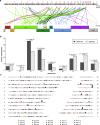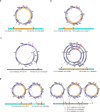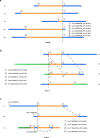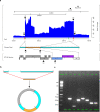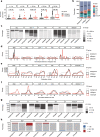Long-read sequencing unveils high-resolution HPV integration and its oncogenic progression in cervical cancer
- PMID: 35538075
- PMCID: PMC9091225
- DOI: 10.1038/s41467-022-30190-1
Long-read sequencing unveils high-resolution HPV integration and its oncogenic progression in cervical cancer
Abstract
Integration of human papillomavirus (HPV) DNA into the human genome is considered as a key event in cervical carcinogenesis. Here, we perform comprehensive characterization of large-range virus-human integration events in 16 HPV16-positive cervical tumors using the Nanopore long-read sequencing technology. Four distinct integration types characterized by the integrated HPV DNA segments are identified with Type B being particularly notable as lacking E6/E7 genes. We further demonstrate that multiple clonal integration events are involved in the use of shared breakpoints, the induction of inter-chromosomal translocations and the formation of extrachromosomal circular virus-human hybrid structures. Combined with the corresponding RNA-seq data, we highlight LINC00290, LINC02500 and LENG9 as potential driver genes in cervical cancer. Finally, we reveal the spatial relationship of HPV integration and its various structural variations as well as their functional consequences in cervical cancer. These findings provide insight into HPV integration and its oncogenic progression in cervical cancer.
© 2022. The Author(s).
Conflict of interest statement
The authors declare no competing interests.
Figures
